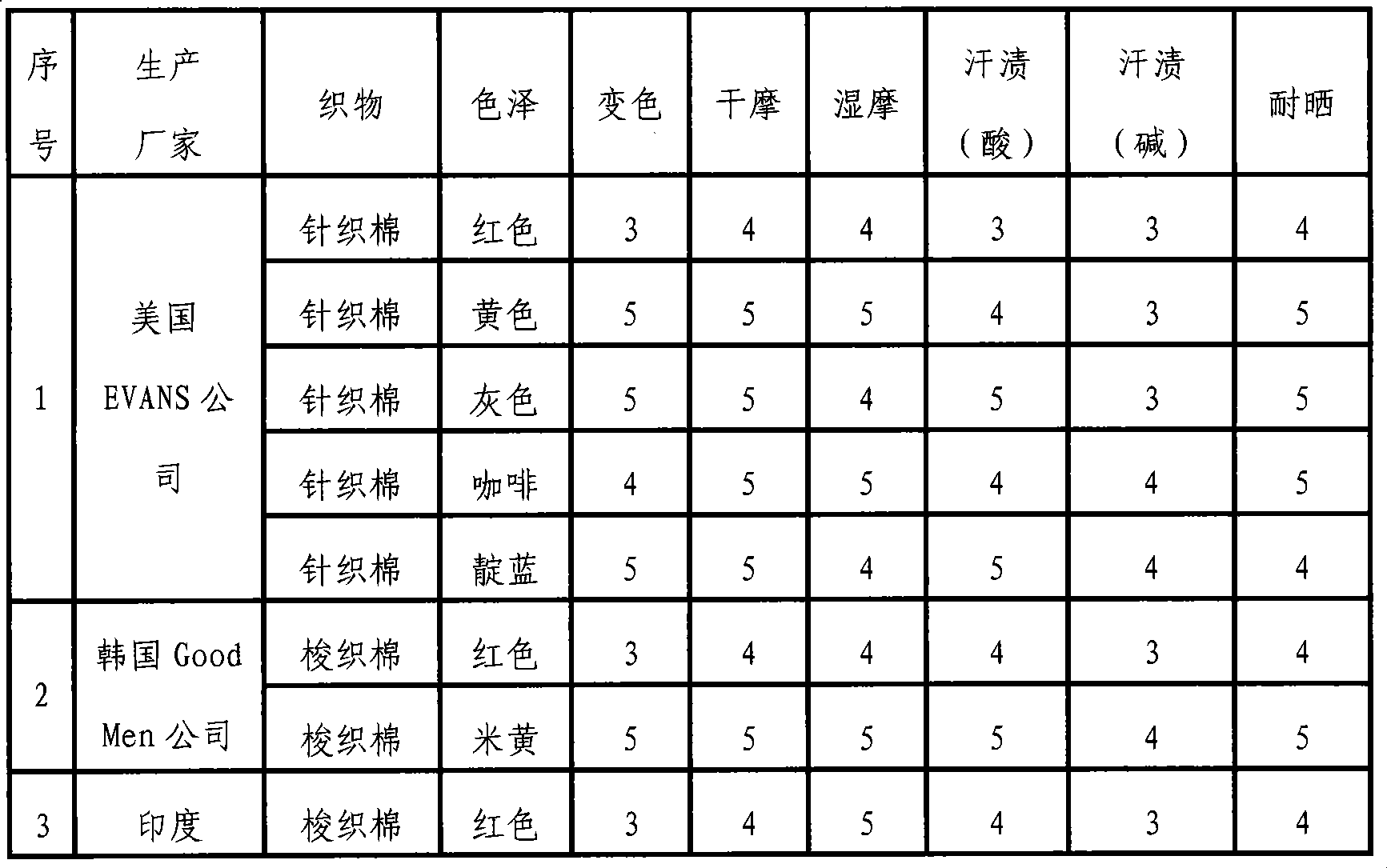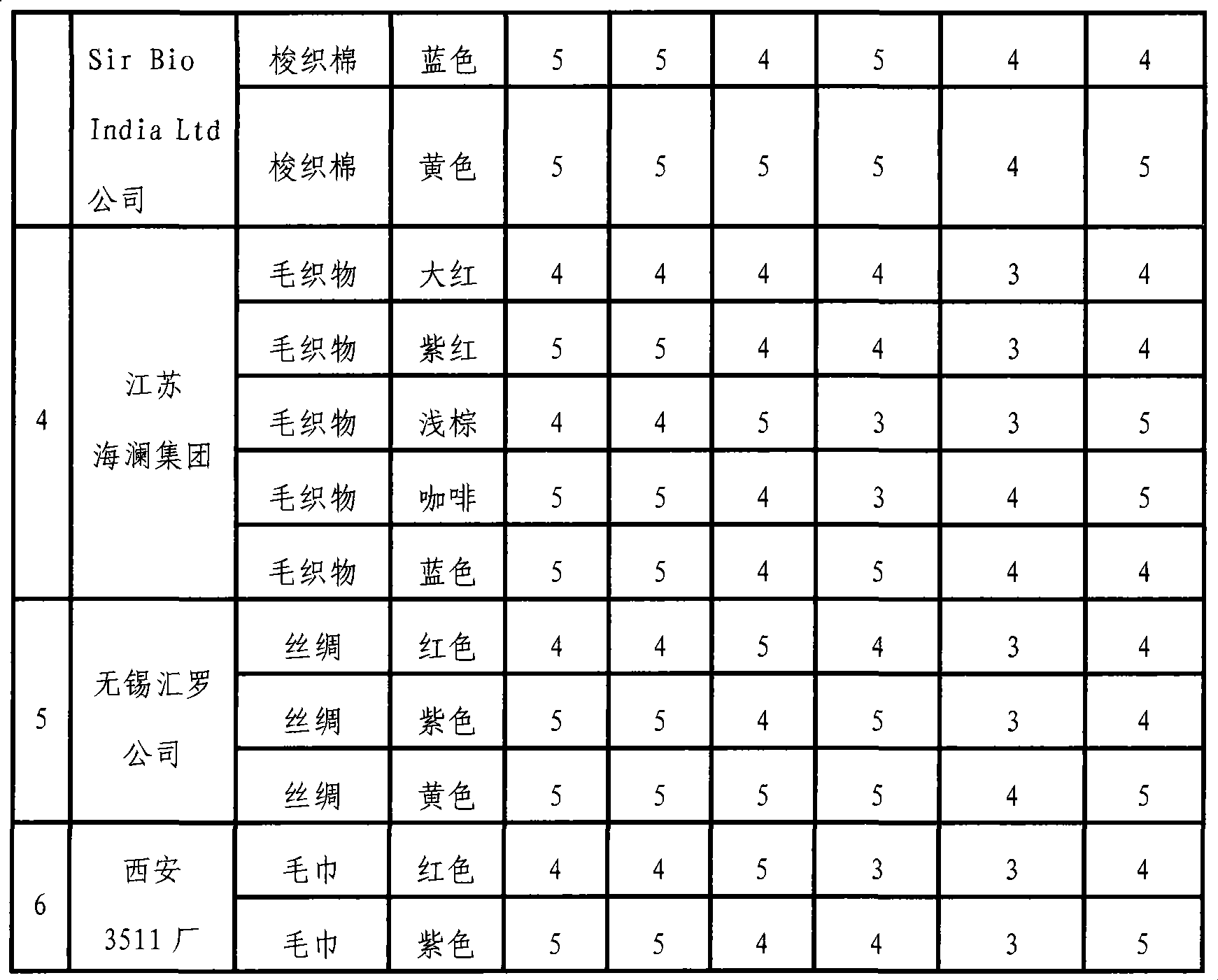Natural vegetable dye textile dyeing and printing technique
A technology of natural vegetable dyes and printing and dyeing technology, applied in the field of natural vegetable dyes textile printing and dyeing technology, can solve the problems of lack of directness and low directness of fibers, and achieve the effects of promoting development, being environmentally friendly, and being beneficial to resource conservation and comprehensive utilization.
- Summary
- Abstract
- Description
- Claims
- Application Information
AI Technical Summary
Problems solved by technology
Method used
Image
Examples
Embodiment 1
[0050] Embodiment 1: natural plant dyestuff to cellulose fiber printing and dyeing process
[0051] The process is as follows:
[0052] (1) Pretreatment: firstly, 5 g / liter a-amylase was used to catalyze the starch size of the hydrolyzed fabric for 50 minutes, the temperature: 50°C, the pH value was 4, the bath ratio: 1:10, and the cotton fabric was desized. Then use catalase to bleach the fabric, temperature: 20°C, pH value 4, catalase dosage is 4 ml / liter, time 15 minutes, then use catalase 1 g / liter, time 15 minutes, normal temperature, Remove residual hydrogen peroxide from fabrics.
[0053] (2) Soaping: Prepare clean water with a bath ratio of 1:10, put it into the cotton fabric and add 0.5g / liter of neutral soaping agent at the same time, raise the temperature to 60°C, keep it warm for 20min, and drain.
[0054] (3) Pre-mordanting: prepare clean water, water hardness <50, bath ratio 1:10, put in cotton fabric and mordant Modi Mahati 2g / liter, start to heat up the morda...
Embodiment 2
[0060] Embodiment 2: natural plant dyestuff to cellulose fiber printing and dyeing process
[0061] The process is as follows:
[0062] (1) Pretreatment: firstly, 6g / liter a-amylase is used to catalyze the starch size of the hydrolyzed fabric for 55 minutes, the temperature: 60°C, the pH value is 5, the bath ratio: 1:10, and the cotton fabric is desized. Then use catalase to bleach the fabric, temperature: 25°C, pH value 5, catalase dosage is 5 ml / liter, time 20 minutes, then use catalase 1.5 g / liter, time 15 minutes, normal temperature, Remove residual hydrogen peroxide from fabrics.
[0063] (2) Soaping: Prepare clean water with a bath ratio of 1:10, put it into the cotton fabric and add 1g / liter of neutral soaping agent at the same time, raise the temperature to 70°C, keep it warm for 25min, and drain.
[0064] (3) Pre-mordanting: prepare clean water, water hardness <50, bath ratio 1:10, put cotton fabric and mordant Modi Mahati 3g / liter, start to heat up the mordant solu...
Embodiment 3
[0070] Embodiment 3: natural plant dyestuff to cellulose fiber printing and dyeing process
[0071] The process is as follows:
[0072] (1) Pretreatment: firstly, 7g / liter a-amylase was used to catalyze the starch slurry of the hydrolyzed fabric for 60 minutes, the temperature: 70°C, the pH value was 7, the liquor ratio: 1:20, and the cotton fabric was desized, Then use catalase to bleach the fabric, temperature: 30°C, pH value 7, catalase dosage is 6 ml / liter, time 20 minutes, then use catalase 2 grams / liter, time 20 minutes, normal temperature, Remove residual hydrogen peroxide from fabrics.
[0073] (2) Soaping: Prepare clean water with a bath ratio of 1:20, put it into the cotton fabric and add 1.5g / liter of neutral soaping agent at the same time, raise the temperature to 80°C, keep it warm for 30min, and drain.
[0074](3) Pre-mordanting: prepare clean water, water hardness <50, bath ratio 1:20, put in cotton fabric and mordant Modi Mahati 5g / liter, start to heat up the...
PUM
 Login to View More
Login to View More Abstract
Description
Claims
Application Information
 Login to View More
Login to View More - R&D
- Intellectual Property
- Life Sciences
- Materials
- Tech Scout
- Unparalleled Data Quality
- Higher Quality Content
- 60% Fewer Hallucinations
Browse by: Latest US Patents, China's latest patents, Technical Efficacy Thesaurus, Application Domain, Technology Topic, Popular Technical Reports.
© 2025 PatSnap. All rights reserved.Legal|Privacy policy|Modern Slavery Act Transparency Statement|Sitemap|About US| Contact US: help@patsnap.com


